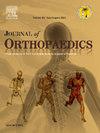Reverse shoulder arthroplasty with isolated latissimus-dorsi transfer/additional teres-major transfer for combined loss of elevation and external rotation: A systematic review and meta-analysis
IF 1.5
Q3 ORTHOPEDICS
引用次数: 0
Abstract
Background
The relative clinical advantages of reverse shoulder arthroplasty (RSA) with latissimus dorsi transfer (LDT) in direct comparison to RSA with latissimus dorsi and teres major (LD and TM) transfer for the treatment of combined loss of elevation and external rotation (CLEER) are not well understood. The objective of this study was to conduct a systematic review and meta-analysis to compare the two surgeries with regards to (1) preoperative severity/indications, (2) range of motion (ROM) outcomes, (3) functional and patient-reported outcomes (PROs), and (4) complications.
Methods
Following screening of three databases in accordance with PRISMA guidelines, 13 studies were included, consisting of 91 and 115 shoulders having received RSA with LDT and with LD and TM, respectively. The primary outcome was the change in external rotation. Secondary outcomes included preoperative Hamada grade and Goutallier score, abduction, forward elevation, and internal rotation, American Shoulder and Elbow Surgeons (ASES) score, Constant-Murley Score (CMS), Simple Shoulder Test (SST), Simple Shoulder Value (SSV), Visual Analog Score (VAS) for pain, and major/minor complications, where available. Meta-analysis was performed using a random-effects model. P-values less than 0.05 were considered statistically significant.
Results
RSA with LD and TM was utilized more often than RSA with LDT for patients with higher preoperative Hamada grade (p = 0.010) and lower subscapularis Goutallier score (p = 0.015). RSA with LDT was associated with a greater improvement in abduction compared to RSA with LD and TM (75.3 versus 55.6°, p < 0.010), but had comparable changes in external rotation, forward elevation, or internal rotation. RSA with LDT was associated with a greater improvement in CMS compared to RSA with LD and TM (44.1 versus 36.4 points, p < 0.010). RSA with LDT was associated with a lower rate of major complications compared to RSA with LD and TM (7.1 versus 20.2 %, p = 0.032).
Conclusions
While improvements of external rotation were comparable, RSA with LDT may offer superior improvement in abduction and CMS, and lower rates of major complications compared to RSA with LD and TM in patients with CLEER. Orthopaedic surgeons may consider these findings in their surgical plan according to a patient's unique anatomy and clinical indications.
Level of evidence
IV, Systematic Review and Meta-analysis of Level I-IV Studies.
用孤立背阔肌转移/附加大臂转移进行反向肩关节置换术治疗合并抬举和外旋功能缺失:系统回顾和荟萃分析
背景反向肩关节置换术(RSA)与背阔肌转移术(LDT)在治疗联合抬举和外旋功能丧失(CLEER)方面的临床优势直接对比背阔肌和大圆肌(LD和TM)转移术(RSA),目前尚不十分清楚。本研究旨在进行系统回顾和荟萃分析,比较两种手术在以下方面的差异:(1) 术前严重程度/适应症;(2) 运动范围 (ROM) 结果;(3) 功能和患者报告结果 (PRO);(4) 并发症。主要结果是外旋的变化。次要结果包括术前 Hamada 分级和 Goutallier 评分、外展、前抬和内旋、美国肩肘外科医生(ASES)评分、Constant-Murley 评分(CMS)、简单肩关节测试(SST)、简单肩关节值(SSV)、疼痛视觉模拟评分(VAS)以及主要/次要并发症(如有)。采用随机效应模型进行 Meta 分析。对于术前 Hamada 分级较高(p = 0.010)和肩胛下 Goutallier 评分较低(p = 0.015)的患者,使用 LD 和 TM 的 RSA 比使用 LDT 的 RSA 更常见。与使用 LD 和 TM 的 RSA 相比,使用 LDT 的 RSA 在外展方面有更大的改善(75.3 对 55.6°,p = 0.010),但在外旋、前倾或内旋方面的变化不相上下。与使用 LDT 和 TM 的 RSA 相比,使用 LDT 的 RSA 在 CMS 方面的改善幅度更大(44.1 分对 36.4 分,p < 0.010)。结论虽然外旋的改善程度相当,但与使用 LD 和 TM 的 RSA 相比,使用 LDT 的 RSA 可为 CLEER 患者带来更好的外展和 CMS 改善,并降低主要并发症的发生率。骨科医生在制定手术计划时,可根据患者的独特解剖结构和临床适应症考虑这些研究结果。
本文章由计算机程序翻译,如有差异,请以英文原文为准。
求助全文
约1分钟内获得全文
求助全文
来源期刊

Journal of orthopaedics
ORTHOPEDICS-
CiteScore
3.50
自引率
6.70%
发文量
202
审稿时长
56 days
期刊介绍:
Journal of Orthopaedics aims to be a leading journal in orthopaedics and contribute towards the improvement of quality of orthopedic health care. The journal publishes original research work and review articles related to different aspects of orthopaedics including Arthroplasty, Arthroscopy, Sports Medicine, Trauma, Spine and Spinal deformities, Pediatric orthopaedics, limb reconstruction procedures, hand surgery, and orthopaedic oncology. It also publishes articles on continuing education, health-related information, case reports and letters to the editor. It is requested to note that the journal has an international readership and all submissions should be aimed at specifying something about the setting in which the work was conducted. Authors must also provide any specific reasons for the research and also provide an elaborate description of the results.
 求助内容:
求助内容: 应助结果提醒方式:
应助结果提醒方式:


